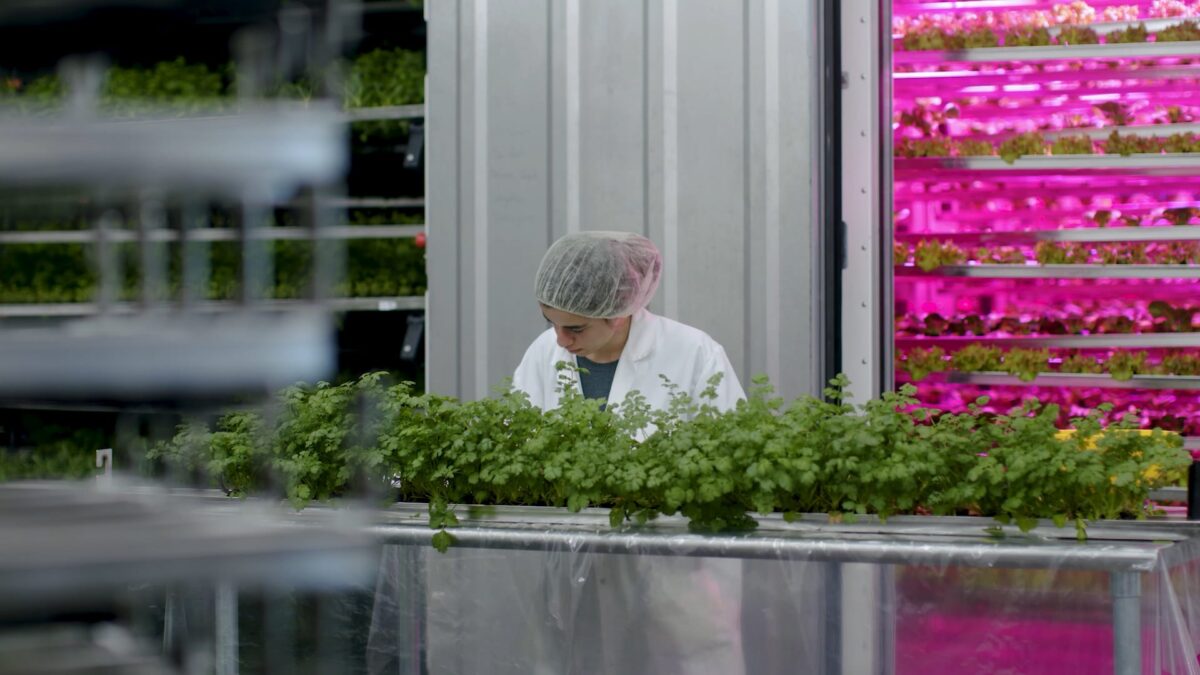
HydroGreen's hydroponic grow system allows for sprouted wheat and barley to be grown indoors for cattle feed, providing a more nutritious feed for cows than alfalfa hay. In the local market, HydroGreen's feed can be valued at $150 a ton.
Written by Frank Lopez
An innovative model for providing livestock feed may be sprouting in the Central Valley. But this feed won’t be grown outside.
HydroGreen, headquartered in Sioux Falls, South Dakota, is a pioneering company in fresh livestock feed, utilizing proprietary technology to grow more nutritious feed quicker in hydroponic greenhouses.
HydroGreen was founded in 2015 by Dihl Grohs, inventing the machines for his farms in South Dakota, Utah and Missouri after being inspired to develop a low-maintenance feed growing system when he was raising cattle in Idaho.
Along with their commercial scale machines, the HydroGreen DGS 66 and HydroGreen GLS 808, the company offers a new take on a burgeoning model — feed as a service.
They have their feed centers on farms in Italy, Japan and Canada. Michael Kyne, chief financial officer of HydroGreen, said the company is working with interested farming operations on memoranda of terms demonstrating their interest in purchasing cow food from a HydroGreen feed center.
The nonbinding contract is used to identify interest in a specific amount of feed and price in a geographic area. Once the demand in a region is identified, HydroGreen begins construction on the feed center.
“The whole concept of feed as a service is something that we decided to come out with so that we could get contracted volumes before the construction of the hub, so business could be set up in advance of the construction and permitting,” Kyne said.
There are plans to construct feed centers in California, two of which will be in the Central Valley.
HydroGreen is partnering with J. & D. Sons Dairy in Riverdale to build a feed center on its property, from which the dairy would purchase 24 tons of sprouted grains such as barley or white a day.
Johann Dairy in Fresno also contracted with HydroGreen for a share in the feed center, with plans to buy 10 tons of feed a day.
Each feed system produces about 34 tons a day.
HydroGreen is a hydroponic growing system consisting of platforms to grow wheat, barley or other grains. Wheat and barley are continually sprouted and harvested, with it taking only 5 to 6 days for these feeds to get to harvest time.
No fertilizer is required, and cultivation is managed with automated seeding, watering and harvesting.
Once harvested, the wheat or barley travels on an automated belt and is shredded, now ready to be fed as a cattle ration.
HydroGreen’s wheat or barley is rationed into cattle feed with a ration of at least 15% for dairy cattle and 30% for beef.
Wheat and barley are much more nutritious for cows than alfalfa hay, Kyne said.
Despite the issues farmers continually face like drought, livestock health and rising costs of feed, the United States farming industry hasn’t invested much in these technologies in the past.
Kyne said that in Europe, where activity is more drought driven, HydroGreen is proving to be popular.
The U.S. doesn’t have the subsidies and incentives for new technologies that European countries do.
Rising interest rates have made it much harder to get bank financing for new equipment.
“The end customer wants the product so we evolved into this concept where we set up the operation, we will grow it, and we will sell you the product. We are seeing tremendous interest in it,” Kyne said.
John de Jonge is the president of HydroGreen and the CEO of Cubic Farms, an ag company producing patented indoor vegetable growing systems for human consumption.
De Jonge purchased machines from HydroGreen and was really impressed with what the company was doing, and CubicFarms acquired the company in 2020.
CubicFarms invested about $30 million in HydroGreen, updating the machines and technology, buying a lot of market confidence from consumers, de Jonge said.
In the last three years, de Jonge said that farmers with around 6,000 cows have not been eager to invest $10 million dollars to own HydroGreen’s feeding center, and would rather buy more land, which is an appreciating value.
However, since dairy and cattle farmers have to buy feed anyway, they’ll buy from HydroGreen. In the last eight months or so, Kyne and de Jonge have been trying to identify areas where there are clusters of cows.
De Jonge said there are plans for a Tulare feeding hub in partnership with Hansen Industries that will consist of two buildings, 20,000 square-feet each, and 10 machines in each building. That plan depends on contracts and funding.
De Jonge said HydroGreen could be operational in the Valley by the spring if all goes according to plan.
He said that along with keeping feed costs lower for farmers, HydroGreen’s feed provides a better pH balance in the cows’ stomach to digest food better — and spend less energy on digestion.
Though different markets could have different prices, the target prices in the Central Valley are $150 a ton for feed as a service.
The results could also mean less emissions — another target of the dairy industry.
“We are giving them much more sugar and less starch, and their stomach is more stable and the pH is balanced,” de Jonge said. “They burp a lot less, so the enteric methane emissions are 25% less when they eat HydroGreen grain.”








